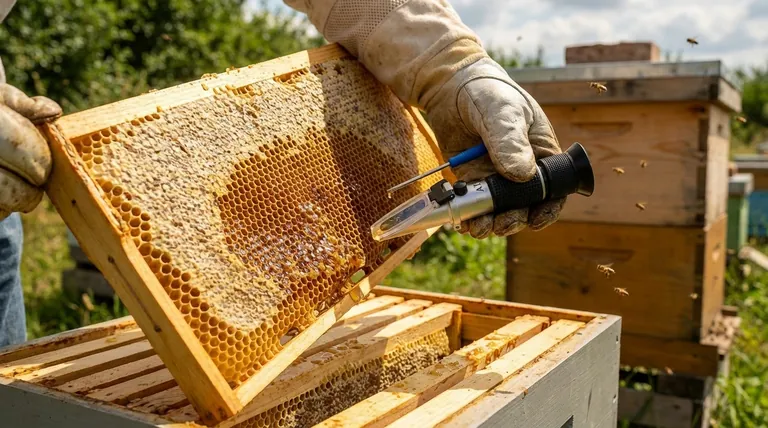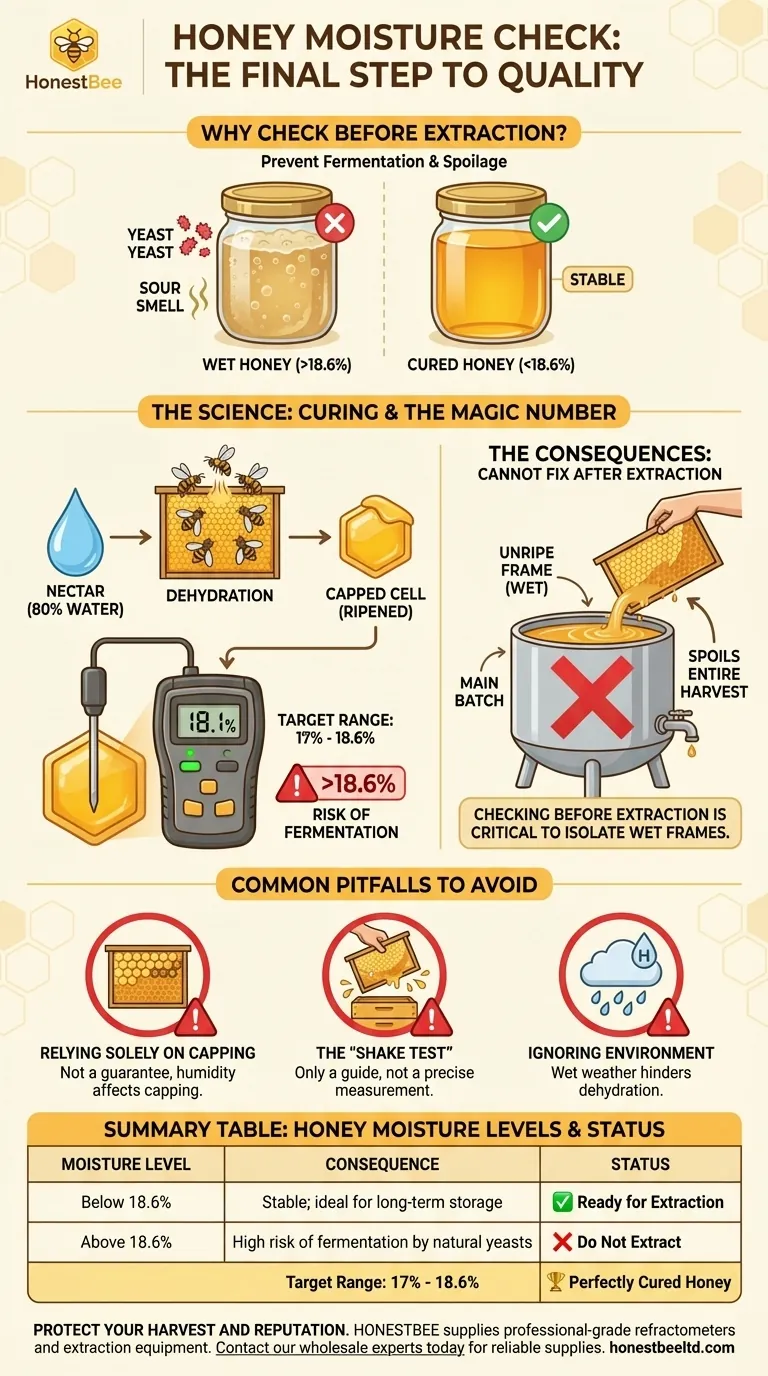To put it simply, you must check the moisture content of honey before extraction to prevent it from fermenting and spoiling. Honey with a moisture level above a specific threshold becomes an ideal breeding ground for naturally occurring yeasts, which will ruin the entire batch. This check is the final quality control step that confirms the honey is stable and ready for long-term storage.
The core issue isn't just about spoilage; it's about ripeness. Measuring moisture content is how you verify that the bees have completed their work of dehydrating nectar into honey. Extracting too soon, before this process is finished, is the root cause of fermentation.

Why "Wet" Honey Is Unstable Honey
Honey's legendary shelf life is not automatic. It is the direct result of having a very low water content, which creates an environment where microorganisms like yeast and bacteria cannot survive.
The Science of Cured Honey
Honey bees create honey by collecting nectar, which is about 80% water. They add enzymes to it and then actively dehydrate it inside the hive by fanning it with their wings.
Once the moisture content drops below approximately 18.6%, the honey is considered "cured" or "ripe." At this point, the bees seal the honeycomb cell with a beeswax cap, signaling it is ready for long-term storage.
The Magic Number: Below 18.6%
The target moisture content for honey is between 17% and 18.6%.
Above this range, osmophilic yeasts that are naturally present in honey can become active. They begin to consume the sugars in the honey, producing alcohol and carbon dioxide as byproducts. This is fermentation.
The Role of Capping
A frame of fully capped honeycomb is the best visual indicator that the honey is ready for harvest. The beeswax capping is the bees' own quality seal.
However, not all honey in a hive ripens at the same rate. You will often find frames with a mix of capped and uncapped cells, which makes a simple visual check unreliable.
The Consequences of High Moisture
Ignoring the moisture content before you uncap the frames and begin extraction can lead to the loss of your entire harvest.
The Certainty of Fermentation
High-moisture honey will eventually ferment. The signs include a sour, "yeasty" smell, a frothy or bubbly appearance, and a change in flavor. Fermented honey is considered spoiled and is not suitable for sale or consumption.
You Cannot Fix It After Extraction
This is the critical point. Once you extract honey from multiple frames, it all gets mixed together. If you mix a small amount of "wet," uncured honey with a large batch of perfectly cured honey, you risk raising the overall moisture level of the entire tank.
This can compromise the stability of your whole harvest. Checking the moisture before extraction allows you to isolate and deal with any unripe frames separately, protecting the quality of your main batch.
Common Pitfalls to Avoid
Many beekeepers, especially those new to harvesting, make assumptions that can lead to spoiled honey.
Relying Solely on Capping
While a good sign, capping is not a guarantee. During a heavy nectar flow or in high-humidity weather, bees may cap honey that is still slightly above the ideal moisture level. Uncapped cells near the bottom of a frame can also hold very wet nectar.
The "Shake Test" Is Only a Guide
A common field test is to hold a frame horizontally over the hive and give it a sharp shake. If liquid nectar flies out of the uncapped cells, the honey is definitely not ready.
However, if nothing shakes out, it doesn't automatically mean the moisture is low enough. It's a useful first pass, but not a replacement for an accurate measurement.
Ignoring Environmental Factors
A rainy or humid season can make it much harder for bees to dehydrate nectar effectively. In these conditions, it is even more critical to measure moisture content rather than just relying on the time of year or visual cues.
Making the Right Choice for Your Harvest
Testing honey's moisture is a small step that protects the significant time, effort, and investment of your beekeeping season. It is typically done with a device called a honey refractometer.
- If your primary focus is a small, personal harvest: A quick check prevents the deep disappointment of seeing your hard-won honey spoil in the pantry. It ensures your efforts result in a high-quality product for you and your family.
- If your primary focus is selling your honey: Measurement is non-negotiable. It is essential for producing a consistent, shelf-stable product that meets legal standards and protects your reputation.
Ultimately, measuring moisture is the final act of partnership with your bees, confirming their work is done before you begin your own.
Summary Table:
| Honey Moisture Level | Consequence | Status |
|---|---|---|
| Below 18.6% | Stable; ideal for long-term storage | ✅ Ready for Extraction |
| Above 18.6% | High risk of fermentation by natural yeasts | ❌ Do Not Extract |
| Target Range | 17% - 18.6% | 🏆 Perfectly Cured Honey |
Protect your honey harvest and your reputation.
For commercial apiaries and beekeeping equipment distributors, precise moisture control is key to profitability. HONESTBEE supplies the professional-grade refractometers and extraction equipment you need to ensure every batch meets quality standards.
Contact our wholesale experts today to discuss reliable supplies for your operation.
Visual Guide

Related Products
- Precision Honey Refractometer Instrument for Quality Assessment
- 0.5T Capacity Honey Dehumidifier Dryer with Vacuum Heating and Thickening Filtering Machine
- HONESTBEE 6 Frame Self Reversing Electric Honey Extractor for Beekeeping
- HONESTBEE 3-Frame Manual Acrylic Honey Extractor
- Plastic Hand Crank 2 Frame Honey Extractor Low Price
People Also Ask
- What are the features of the Standard Refractometer for honey moisture content? Essential Tools for Quality Control
- What is a honey refractometer and what is its purpose? Ensure Honey Quality and Prevent Spoilage
- How does a honey refractometer work? Ensure Honey Quality & Harvest Readiness
- What are the key points for proper usage of a honey refractometer? Ensure Accurate Moisture Readings Every Time
- What are the key steps to using a honey refractometer? Ensure Honey Quality & Prevent Fermentation



















